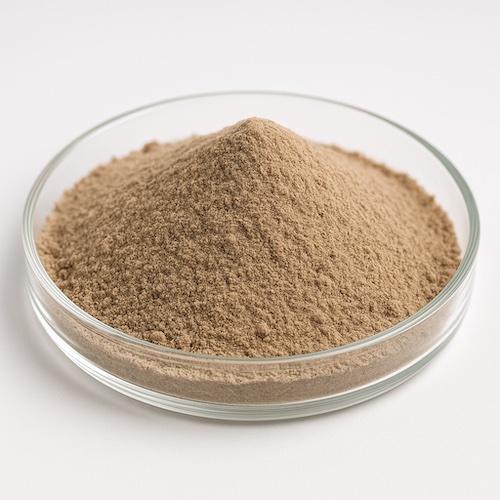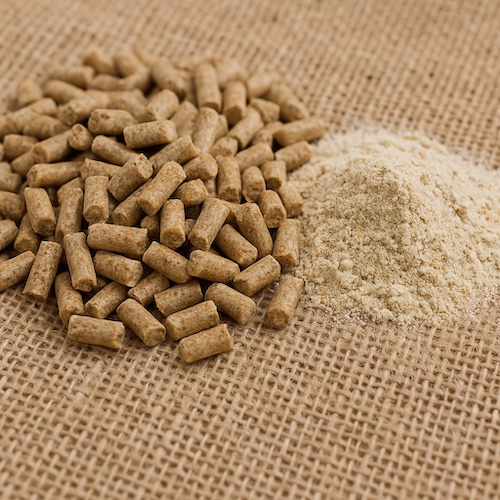Disadvantages of using starch in aquatic feed and suitable pellet binders to replace starch
Starch is one of the pellet binders used in some factories producing aquatic feed. However, aquatic nutrition experts believe that this combination is not suitable for many aquatic species, especially carnivorous ones like salmon. In the following, we will examine this issue and suggest why using a specialized binder pellet instead of starch in aquatic feed is preferable.
Starch is one of the most abundant macromolecules, consisting of glucose units with glycosidic bonds that store energy in the form of grains ranging in size from 1 to 100 micrometers. In terms of feed processing, its performance depends on both the amount and degree of polymerization. Starch is comprised of amylopectin, which is low density and soft amorphous, and amylose, which is high density and hard semi-crystalline. The ratio and shape of these components vary across different sources. Generally, starch molecules undergo modification either through enzymatic processes or chemical changes.
In enzymatic digestion, the primary carbohydrate enzyme, amylase, serves as a crucial catalyst in converting starch into sugars and alcohols. Conversely, in chemical conversion, starch undergoes modifications to function as a binder, emulsifier, thickener, or stabilizer. These modifications occur through various processes such as oxidation, gelatinization, and dextrinization. Due to its thickening properties, starch finds extensive use in human food, livestock, poultry, and aquatic industries. It is intentionally included in the formulation of aquatic feed for its thickening effects.
However, the difference in using starch in aquatic feed lies in its lack of nutritional value for aquatic animals. The inclusion of starch in fish diets varies among species: carnivores typically receive around 20%, omnivores range from 25% to 45%, and vegetarians typically receive between 30% to 50%. This variation is due to differences in nutritional habits, digestive capabilities, and the efficiency of starch utilization.
The function of starch in aquatic feed is primarily to provide inexpensive energy for the host, thereby conserving the catabolism of proteins and fats. Additionally, starch acts as a thickener to enhance the quality of pellets or extruded granules.
Sources of starch in aquatic feed
Starch is a common carbohydrate source in aquaculture feed and can be obtained from a variety of sources. Commonly used starches include corn, wheat, rice, barley, and sorghum. In addition, starchy root crops including potato, sweet potato, and cassava are processed to obtain starch-rich materials for use in aquaculture. Some legumes such as soybeans, beans and peas also contain starch. Tubers as well as rhizomes can also be included in aquatic feed. Starchy by-products from food processing industries, such as distillation residues, can also be added to aquafeeds. Algae and seaweed are also used as alternative starch sources in expensive aquatic feeds.
gelatinization
Starch grains are composed of water-soluble amylopectin and water-insoluble amylose structures. Gelatinization is initiated by heating the starch at 60-80°C in water, which results in water absorption and swelling. This leads to gel formation of wet amylose, melting of crystalline regions and loss of molecular complexity. Swollen grains disintegrate into smaller grains. The degree of gelatinization varies according to the ratio of amylose to amylopectin of starch, species and plant strain. On the other hand, non-waxy starches form strong gels during cooling due to their high amylose networks with other materials, while low-amylose waxy starches require low temperatures but lack strong gel formation after cooling.
Consequences of starch gelatinization on the physical characteristics of aquafeed Commercial aquafeeds are generally made by extrusion technology, in which the proportion of floating or sinking grains that can be produced is very flexible. For floating grains, high temperature and pressure are required to increase starch gelatinization.
In addition, the type of starch also affects the type of pellet. For example, waxy starches produce less dense and more expansive grains because their branching bonds are weaker. Therefore, it is necessary to optimize the extrusion temperature and pressure according to the ingredient. In addition, other nutrients in the food matter also play an important role in the degree of gelatinization. It was also reported that the high fat content in the diet acts as a lubricant and reduces the gelatinization time. However, higher processing temperature may solve this problem, but it leads to increased oxidation of fats such as long-chain PUFA and degradation of vitamin C in the diet. Therefore, higher temperature gelatinization potentially reduces the quality of high-fat aquafeeds.
The effect of starch gelatinization on digestive enzymes
Starch gelatinization generally increases with digestibility, but the effect of growth on aquatic species is highly variable. Moreover, growth enhancement depends on various factors such as species-specific differences, starch type, ratio of gelatinized starch to raw starch, etc. Modified starch affects amylase enzyme activity because the starch structure is more accessible. An increase in trypsin activity has also been observed. Inside the fish body, this effect was detected by increasing the activity of enzymes (aspartate and alanine aminotransferase) responsible for gluconeogenesis and glycolysis.
Effect of starch gelatinization on water quality
The production of fish waste in the form of ammonia or faeces is related to the amount of feed given and its absorption rate. There are indications that modified starches in the diet can potentially minimize the decline in water quality due to better digestibility of gelatinized starches. In a study, it has been observed that the production of feces is reduced when using modified corn starch as a result of better digestibility of lipids, proteins and starch, higher viscosity and reduced short-chain fatty acids (SCFA) in a controlled settling tank.
Limitations
Gelatinization of starch leads to the formation of indigestible complexes with minerals and increases the digestive viscosity and decreases the absorption of minerals. Increased starch digestibility often leads to decreased intestinal short-chain fatty acids, which compromises immunity and disease resistance. In addition, excessive starch digestibility leads to the accumulation of a large amount of glycogen and lipids in the host, which leads to impaired liver growth and function. Another limitation in the use of modified starch in aquaculture feed is its potential for gelatinization during feed processing, which may lead to reduced feed pellet integrity, increased feed dust, and excessive feed strength due to It leads to hydration and rapid dissolution. In addition, due to the change in texture and water holding capacity, it can affect the palatability and overall digestibility of the food in the digestive system of aquatic animals.
Pellet binder, binder or adhesive suitable for aqua feed instead of starch
Today, in the production of aquatic feed, new binders are utilized, which offer advantages such as no interference in nutrition, high performance with low consumption, and the production of quality feed in terms of physical and nutritional characteristics. Sepehr Saman Fartak Additives Company has successfully introduced the A-Bind product to this industry, combining modified starch and other feed thickening compounds. For further information about this product, please feel free to contact our experts through the provided communication channels.



